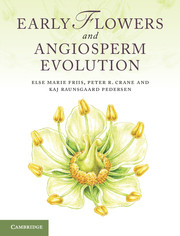Book contents
- Frontmatter
- Contents
- Preface
- 1 Introduction to angiosperms
- 2 The nature of the angiosperm fossil record
- 3 The environmental context of early angiosperm evolution
- 4 Stratigraphic framework and key areas for Cretaceous angiosperms
- 5 Angiosperms in context: extant and fossil seed plants
- 6 Origin and age of angiosperms
- 7 Phylogenetic framework and the assignment of fossils to extant groups
- 8 Fossils near the base of the angiosperm tree
- 9 Early fossil angiosperms of uncertain relationships
- 10 Early fossils of eumagnoliids
- 11 Fossils of monocots
- 12 Fossils of eudicots: early-diverging groups
- 13 Fossils of core eudicots: basal lineages
- 14 Fossils of core eudicots: rosids
- 15 Early fossils of eudicots: asterids
- 16 Patterns of structural diversification in angiosperm reproductive organs
- 17 History and evolution of pollination in angiosperms
- 18 History and evolution of dispersal in angiosperms
- 19 Vegetational context of early angiosperm diversification
- 20 The accumulation of angiosperm diversity
- References
- Index
5 - Angiosperms in context: extant and fossil seed plants
Published online by Cambridge University Press: 07 September 2011
- Frontmatter
- Contents
- Preface
- 1 Introduction to angiosperms
- 2 The nature of the angiosperm fossil record
- 3 The environmental context of early angiosperm evolution
- 4 Stratigraphic framework and key areas for Cretaceous angiosperms
- 5 Angiosperms in context: extant and fossil seed plants
- 6 Origin and age of angiosperms
- 7 Phylogenetic framework and the assignment of fossils to extant groups
- 8 Fossils near the base of the angiosperm tree
- 9 Early fossil angiosperms of uncertain relationships
- 10 Early fossils of eumagnoliids
- 11 Fossils of monocots
- 12 Fossils of eudicots: early-diverging groups
- 13 Fossils of core eudicots: basal lineages
- 14 Fossils of core eudicots: rosids
- 15 Early fossils of eudicots: asterids
- 16 Patterns of structural diversification in angiosperm reproductive organs
- 17 History and evolution of pollination in angiosperms
- 18 History and evolution of dispersal in angiosperms
- 19 Vegetational context of early angiosperm diversification
- 20 The accumulation of angiosperm diversity
- References
- Index
Summary
Over more than a hundred years, a vast literature has accumulated on the origin of angiosperms, but different authors have approached the question in different ways. Many studies have focused solely on extant angiosperms, seeking to establish which groups are most primitive, largely based on ideas about the evolution of angiosperm flowers. Others have sought to identify one or more ancestral groups from which angiosperms may have been derived, often based on ideas about how specific angiosperm features (e.g. flower, carpel, stamen) may have evolved from the reproductive structures of other fossil seed plants (e.g. Gaussen, 1946; Melville, 1962, 1963; Retallack and Dilcher, 1981b; Krassilov, 1997). Palaeobotanical data have also been used to constrain the time and place of angiosperm origin (e.g. Doyle, 1969; Doyle and Hickey, 1976; Hughes, 1976), to expand the known diversity within the seed plant clade and also to identify putative ‘proangiosperms’ (e.g. Thomas, 1925). Some extreme views (Hughes, 1976, 1994) have argued that palaeobotanical data alone, divorced almost entirely from studies of living plants, hold the key to understanding angiosperm origins.
A modern approach to understanding the origin of angiosperms reduces fundamentally to recognising the major groups of land plants and understanding how they are phylogenetically related (Hill and Crane, 1982; Crane, 1985a). This approach focuses on developing a well-corroborated hypothesis of relationships among living and fossil seed plants. It implies that the pattern of relationships will inform ideas on how the characteristic features of angiosperms may have evolved, as well as the nature of the evolutionary transitions and processes that may have been important in angiosperm origins.
- Type
- Chapter
- Information
- Early Flowers and Angiosperm Evolution , pp. 101 - 140Publisher: Cambridge University PressPrint publication year: 2011

